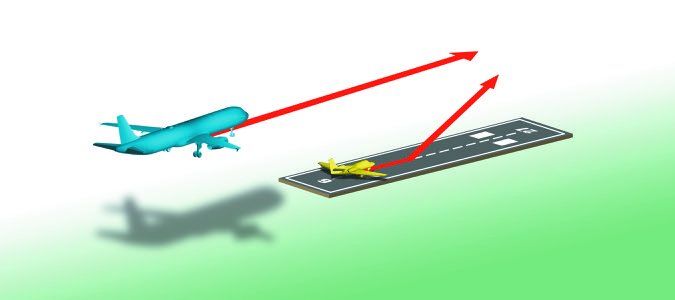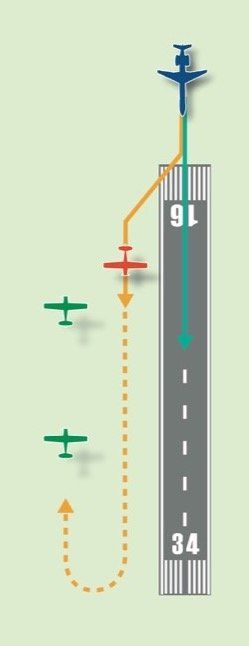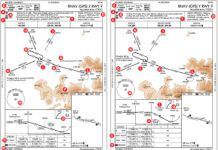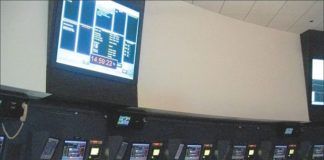Your favorite phrase as a pilot probably isn’t, “Go around.” You might have been set up on final, aircraft perfectly configured, ready to call it a day, and suddenly you’ve got to throw all that out and try again.
For a controller, the go-around is a last-minute tactic to resolve insufficient clearance or some other unexpected danger. Sure, it fixes an immediate problem, but it instantly creates other risks. Whether ATC initiates it, or you do, it’s adding complexity for everyone involved.
In the cockpit, procedures require careful consideration and execution. How smoothly should you lay in the power? How fast should you adjust the trim? At what speed do you retract the flaps? It’s a scenario commonly practiced during flight training, but actually executing it under surprise real-world conditions can be challenging.
The trick is to not make a less-than-ideal situation worse. Over in the control tower, we air traffic controllers are doing our own dance. Our goal? Ensuring that, when a go-around occurs, we stay ahead of the traffic and act decisively and safely. What once was a landing aircraft is now a departure, and it needs to be put somewhere. That “somewhere” has to be where other airplanes aren’t.

Placing Bets
Air traffic control is a judgment game. Controllers weigh multiple factors when making a control decision, including aircraft performance, speeds, distances, and even observed pilot skill level. Would I clear a student pilot in a Cessna 172 for takeoff with a Boeing 737 clocking 130 knots on a three-mile final? Never. But reverse it—an 85 knot Skyhawk three miles out and a 737 ready to go—and I would do it all day, every day. The math just works out.
We analyze, we observe, and make the go/no-go call. In the end, it’s risk assessment. If I clear aircraft A for takeoff with aircraft B on final, will I have the spacing I need? Through training and experience, we learn what spacing usually works with different aircraft types. However, we always have that go-around as our “out.”
The other day, I had a situation involving three aircraft. Airbus A320 #1 was on short final, A320 #2 was five miles in trail, and a Boeing 737 was waiting at the hold short line. After A320 #1 crossed the runway threshold, I put the 737 in line up and wait (LUAW) status, telling both the 737 and A320 #2 about each other. Thisshouldhave worked all day.
Well, the first A320 rolled out excessively long, using up the entire runway while everybody else had been using far less. I can’t clear an aircraft for takeoff until the runway ahead is completely clear. My thumb was on the radio trigger, but I couldn’t fire. Meanwhile, Airbus #2 was barreling down the final, the 737 sitting in his way.
At last A320 #1 vacated the runway. I told the 737, “Cleared for immediate takeoff.” There was still time, but the 737 just sat there. And sat there. “No delay,” I told him. No movement. A320 #2 was short final now. The 737 finally started to move. However, I need 6000 feet between two jets and for at least one to be airborne (i.e. the 737 needed to lift its main wheels before the A320 touched down). Not happening here. I issued the instruction to the second A320: “Go around. Maintain 4000.”
I had weighed all the factors. Similar type aircraft? Check. Available spacing? Five miles was plenty of room. Runway exiting trends? Other arrivals had exited the runway in a timely manner. Aircraft performance? Some 737 operators do long, reduced-power takeoff rolls. This was not one of those airlines, so it should have rolled and lifted quickly, especially after being given an “immediate” takeoff clearance. Nevertheless, it didn’t work out, and A320 #2 had to take a lap.
Sample “Unplanned Missed Approach” Procedures | |||
Runway | Aircraft Type | Heading to Assign | Altitude to Assign |
Runway 9 | Jet | Runway heading | 3000 |
Runway 9 | Prop | 120 | 2000 |
Runway 27 | Jet | Runway heading | 3000 |
Runway 27 | Prop | 240 | 2000 |
Runway 18 | Jet | Runway heading | 3000 |
Runway 18 | Prop | 150 or 210 | 2000 |
Runway 36 | Jet | Runway Heading | 3000 |
Runway 36 | Prop | 320 or 030 | 2000 |
Whipping Out the Crowbar
The only constant in air traffic is change. Sixty seconds ago, I had a great plan, formulated from the best information I had available. Now, that plan’s gone to crap, and I need to act fast. I’ve got one airliner full of 150+ people on short final going around, accelerating, reaching for the sky, and another one directly beneath it on takeoff roll. Any second now, that 737’s going to lift off that runway, and if that A320’s directly over it … well, that’s a “bad thing.”

The easiest solution? Turn one of them. Which one? Well, let’s think about it. Again, we’re assessing multiple factors. The 737 is just rotating off the ground and is in a critical phase of flight. The A320 cleaned up its gear and is accelerating quickly, so it’s in a better maneuvering position.
Let’s look ahead, too. The A320 already had its flight interrupted by the go-around and needs to be vectored around for another landing attempt. The 737, so far, has not had its departure instructions altered. A turn off that expected track would just add disruption to both the crew and the departure radar controller receiving the aircraft.
The decision here almost makes itself. Why mess with two flights if we can just work with one? So, I’ll turn the A320. How much of a turn? Well, there’s another factor. For my legal IFR separation purposes, I need either three miles between them, a thousand feet vertically, or to have their courses diverge by at least 15 degrees. I’ll use the latter—divergence—and will give it a 20-degree turn.
Next question: which way to turn? Let’s keep staring into the future. The departing 737 is initially flying runway heading, but its filed routing will eventually require a left turn. Giving the A320 a 20-degree left turn, while certainly legal divergence, would essentially cut the 737 off and prevent the departure controller from turning the 737 on course until they’re able to bend or climb the A320 out of its way. Left is not a good option if we’re trying to avoid messing with that 737. So, I go with 20 degrees right for the Airbus. Nobody steps on anyone’s toes.
Before I turn the A320, I scan for conflicting traffic. Thankfully there was none. However, what if that 20-degree right turn puts the A320 in the face of someone on downwind? That won’t work. Maybe I’d leave the A320 runway heading for the moment, stop the 737 at a lower departure altitude than usual, and issue the A320 an altitude 1000 feet above it, giving myself the needed separation. Once the Airbus passes my downwind traffic, I give him the turn and climb the 737.
Clarity in the Chaos
That’s a lot of thinking. What heading? What altitude? What radar sector should they be talking to on the go?
Every airport is different. Some have crossing runways, where a go-around might conflict not only with the traffic on its runway, but traffic arriving or departing another runway. There have been some serious incidents where this has happened. Also, even if the crossing traffic isn’t a collision factor, if a heavy goes around in front of a departing Learjet, the Lear could be in for a rough ride.
To alleviate much of this guesswork, control towers and their overlying radar facilities have letters of agreement (LOAs). Within their pages—along with standard departure headings, departure altitudes, and a lot of other critical information—are procedures for “unplanned missed approaches,” the fancy way of saying an IFR “go around.”
They’re basically if/then statements.Ifan aircraft goes around on a particular runway and is a particular type of aircraft (prop/turboprop/jet),thenthe tower controllers must assign it a particular heading and altitude, and hand it off to a particular radar sector. Controllers on the tower and radar sides memorize these procedures during training, so they know what to expect. They’re proven procedures that (usually) work great.
However, just because something’s written down doesn’t mean it goes that way every time. Remember how we’re supposed to keep bad situations from worsening? If following these procedures does just that, then we need to do something else. For instance, what if the prescribed heading or altitude directs the plane into an extreme thunderstorm or another aircraft?
That’s when controllers start talking with one another. There’s a common ATC saying: “Anything is possible with coordination.” If a tower or radar controller sees a conflict, they call their counterpart and hash out a solution.
For instance, what if the normal Runway 9 procedures call for a jet going around to fly runway heading (090), but Tower has a Piper Cherokee N461 in the upwind? The jet would quickly eat the Piper. The tower controller could call Radar and say, “Citation Six Bravo Victor is going around. Reference Cherokee Four Six One, ApReq (Approval Request) a 120 heading for the Citation?” If Radar sees no issues with it, all they need to say is, “Approved.” Then Tower would assign the 120 heading to the Citation and bend him away from the slower Cherokee.
Usually, LOAs call for the go-around to be handed back to Radar for resequencing with other arrivals. Here again, Tower can take the initiative. If I see nobody else inbound, I’ll ask Radar if I can just keep the aircraft in my pattern. I’ve done that with everything from piston singles to heavy jets. “Make left traffic. Runway 9, cleared to land,” works the same for any aircraft. It saves time and flying miles for the aircraft and workload for the radar controller.
Communication
While I’ve spent time talking about jets, the formulas remain the same for all aircraft. A 150-knot jet on a five-mile final would get to the runway at the same time as a 75-knot Cherokee on a two and a half mile final. Radar separation rules still apply: three miles horizontally, 1000 feet vertically, or at least 15 degrees of divergence. But, our runway separation requirements do change. Between light single-engine prop aircraft and twin-engine props, we need 3000 feet or 4500 feet nose-to-tail, respectively, instead of the 6000 required between aircraft heavier than 12,500 pounds.
Regardless of what you’re flying, if you need to go around, first fly your aircraft. Follow your checklists. However, please advise ATC as soon as possible. Nothing complicated—just a simple, “November Three Alpha Bravo is going around.” That’s enough to get the controller making a clear path for you. Expect a heading and altitude to fly, and a possible frequency change in the near future.
Once things settle down, ATC may ask you the reason for the go-around, since we need to know if that reason impacts other aircraft. You can volunteer it as well. One day, a large military transport aircraft suddenly went around on me. “We’re going around. Large flock of black birds on short final.” Now I knew to issue bird advisories to all arrivals and get airports ops to do something about the birds.
On the ATC side, we try not to wait to the last second to issue a go-around. Often, we can see in advance that the spacing we need isn’t materializing. In those situations, I may prep the pilot, “Continue for the runway. Expect to go around on short final.” That said, while mitigating surprises is ideal, we can’t plan for the unexpected. Runway incursions? Confused student pilots? Engine failures in the pattern? Landing gear collapses? I’ve seen all that and plenty more, and sent all types of aircraft around to get them out of harm’s way.
Controllers also prioritize based on the aircraft’s mission. What if a flight school Cessna that’s been practicing touch and goes for an hour is getting eaten up on final by an arriving airliner? I weigh the overall impact. For the airliner to go around, that’s thousands of pounds of fuel, a delay for 200 people, and a considerable workload increase for the radar controller who’ll vector it for another try. Sending the Skyhawk around costs them a few minutes and a gallon or two, they stay with the tower, and, well, it might even be good training for the student pilot.
A go-around is the result of an unfortunate reality: something’s just not working out, whether it was ATC’s plan, the pilot’s approach, or something unexpected. While a temporary fix for one problem, it now shoves everyone involved into uncharted territory. Getting from there to another landing attempt safely requires both controllers and pilots to make the best choices moving forward.




